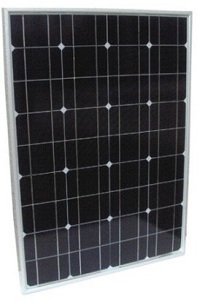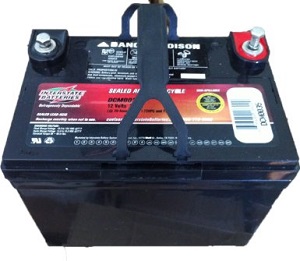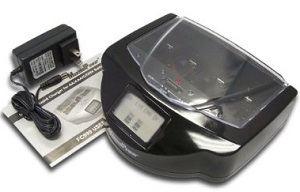 Years ago I took my first steps into creating my very own off-grid solar power setup. Since then I’ve upgraded a bit by adding more solar panels and deep cycle batteries and, honestly, I never feel like it’s enough. I could, in fact, spend $20K and not have what I wanted! That said, having some ability to power small devices, including to charge phones, run a laptop, and, yes, recharge batteries in a SHTF situation should not be overlooked. In fact, you could turn a several hundred dollar investment now into a real post-shtf money-maker that people will beg you to use!
Years ago I took my first steps into creating my very own off-grid solar power setup. Since then I’ve upgraded a bit by adding more solar panels and deep cycle batteries and, honestly, I never feel like it’s enough. I could, in fact, spend $20K and not have what I wanted! That said, having some ability to power small devices, including to charge phones, run a laptop, and, yes, recharge batteries in a SHTF situation should not be overlooked. In fact, you could turn a several hundred dollar investment now into a real post-shtf money-maker that people will beg you to use!
Alright, maybe it won’t be THAT awesome but it does provide options for your own use and–should you choose–potential leverage as a viable bartering business. After all, what would most sheeple not give to keep a few lights on at night for their kids or to run a radio so they can suck down the vital information being graciously force-fed to them? I’m sure they would give a lot.
I should first note that I’m not a fan of bartering; I really feel like it’s a chance most of us shouldn’t take until things have seriously settled down. I should also point out that I didn’t come up with this potential business on my own. I actually posed a question a while back on my facebook page (don’t run off yet for those that despise FB) basically asking “if you had $1000 to spend what would you spend it on?” One commenter mentioned more solar panels to start a battery recharging business and I though, “hey, that’s a good idea!” And, since I already had most of what I needed it was just a matter of adding one extra piece, but I’m getting ahead of myself.
Now, if you’ve never thought about off-grid power there are plenty of resources available, from power-related videos I keep in the Video Vault to a variety of “how to” posts and even people who know this stuff much better than I do. I’m sure there are plenty of other videos and references I’ve found in the past if you wanted to search for them on my site. And, of course, there’s all-knowing Google Search.
Regardless, let’s boil it down to the basics here today…
Solar Panels
 This is usually the first thing that anyone thinks about when it comes to an off-grid power system, and rightfully so. After all, solar panels are all the rage these days… everybody’s got one! You, specifically, need more than one to make this business happen. The problem, however, is that solar panels come in many shapes and sizes (from rigid panels to flexible ones for backpacking), a wide range of costs, power output, and not all panels are created equally in terms of quality and durability.
This is usually the first thing that anyone thinks about when it comes to an off-grid power system, and rightfully so. After all, solar panels are all the rage these days… everybody’s got one! You, specifically, need more than one to make this business happen. The problem, however, is that solar panels come in many shapes and sizes (from rigid panels to flexible ones for backpacking), a wide range of costs, power output, and not all panels are created equally in terms of quality and durability.
Suffice it to say that a small 20-watt solar panel is probably not going to cut it if you want to create a viable off-grid battery recharging system. I would say that at minimum you would need 100-watts to make this idea a possibility and probably more like 200-watts (to more like 500-watts) or more in most cases. Why do I say this? Just from my own experience and experiments. I’m sure there an electrical engineer could pinpoint precisely what you need but that’s not me.
What type should you get? Well, I had started with a simple 20-watt panel made by HQRP and it’s a fine solar panel but not nearly large enough for this purpose. Instead, I would need three or four 50-watt panels to make this recharge station remotely viable. Personally, I like HQRP panels but I know many people perfer Harbor Freight solar panels… I can’t vouch for Harbor Freight panels as I’ve never purchased any.
Anyway, the general rule of thumb is that you want twice as many watts output by your solar panel as you have in battery storage (discussed next). Could you get away with less? Usually. But, if you want something you can rely upon as well as something that is relatively resilient then two-times your battery storage is the goal due to problems like less power output on overcast days, less solar power in the winter, degradation of solar panels as the years pass on and more.
Deep Cycle Batteries
 The next major piece of the puzzle you need is power storage in the form of a few to several deep cycle batteries. While it may be possible to salvage random car batteries (after all, nobody’s going to be driving and so car batteries will be abundant) you would probably need to use a lot of normal car batteries for a recharge station such as this one because they’re not meant to be discharged much more than a few percent of their total capacity. Deep cycle batteries, on the other hand, can be deeply discharged without damaging them and are perfect for this purpose.
The next major piece of the puzzle you need is power storage in the form of a few to several deep cycle batteries. While it may be possible to salvage random car batteries (after all, nobody’s going to be driving and so car batteries will be abundant) you would probably need to use a lot of normal car batteries for a recharge station such as this one because they’re not meant to be discharged much more than a few percent of their total capacity. Deep cycle batteries, on the other hand, can be deeply discharged without damaging them and are perfect for this purpose.
As for what to purchase? Well, I’ve seen all sorts of recommendations and while you can even purchase batteries online you should really just look locally. Sometimes you can find them on Craigslist or maybe even get really lucky and find old golf cart batteries somebody is getting rid of. But, since most of us are probably not that diligent (or lucky) the best place to find new deep cycle batteries is probably your local warehouse (e.g., Sam’s club) or marine store.
How much do you need? Well, this is where some math comes in. Let’s say you wanted to recharge four AA alkaline batteries. A typical AA alkaline battery holds a little over 2200-2400 mAh, or 2.2 to 2.4 amps of power. In reality it will be something less than that because a typical alkaline battery won’t be recharged to it’s full capacity again… let’s just say it’s 2 amps of current to make the math easy. Four of these batteries, therefore, would require a little over 8 total amps to charge completely. Granted, most batteries aren’t totally dead and won’t ever get fully charged again so maybe it’s a little less overall current needed, but we’ll say it’s 8 amps just to be safe and make math easier.
Now, if I had a 40-Ah (amp-hour) deep cycle battery, you might think I could recharge four sets of AA batteries five times over because 40 Ah available in my deep cycle battery divided by 8 amps needed to charge the batteries is 5 times. Well, sadly, it’s not that easy since another rule of thumb is that you never want to fully discharge a deep cycle battery beyond 50% otherwise bad things begin to happen, the world stops spinning, and the zombie apocalypse will ensue. 😉 Actually, that’s not entirely true, it’s just harder to get the deep cycle battery to fully recharge so just remember never discharge below 50% and you’ll be fine. Ultimately, this means I would only be able to recharge four typical AA alkaline 2.5 times (probably more like two times in reality but maybe three times depending on the state of discharge of the AA batteries) without worrying about needing to recharge my sole deep cycle battery… make sense?
The problem is that if you want to turn this into a viable post-SHTF business only being able to recharge four AA batteries two or three times isn’t going to do much. You’ll probably want to be able to recharge more batteries at a time, right? Well, you’re going to need more power and that’s where you need more deep cycle batteries. How many is up to you and it certainly depends on how large the batteries are that you get so I can’t just say you need four deep cycle batteries and be done with it. You want to judge by amp-hours and the more the merrier, if you ask me. Let’s say 200 amp-hours is a good start and if that’s the case then you would want about 400-watts of panels.
Now, beyond that you’re probably going to want to be able to charge batteries other than just AA batteries, including D-cell batteries and even non-alkaline batteries too. But, if we just concentrate on D-cells for a moment, a single D-cell holds about 12,000-17,000 mAh (or 12-17 amps) of power which is quite a bit more than your average AA battery! For example, if I wanted to fully charge four D-cell batteries I would need between 48-68 amps of current, which could easily be larger than a single deep-cycle battery (depends on the battery size, of course). Would you really need that much current to charge these batteries? No. Again, depending on the depth of battery discharge of the D-cell batteries as well as other factors the actual current used will be something less than what the math suggests. Regardless, it’s not a small number for sure! You simply must have MORE batteries to store MORE current.
Battery Charger
 If you’ve noticed I keep bringing up alkaline batteries and for a good reason: I figure most people are going to only have alkaline batteries that they need recharged and so you’ll then need a battery charger that can recharge them. In this case, a typical battery recharger–meant for rechargeable batteries–won’t work with alkaline batteries because alkaline batteries were designed to take the larger current and heat generated from a rechargeable battery charger. If you tried to use a rechargeable battery charger with alkaline batteries, then it with either sense the fact that you’re using alkaline batteries and just not work or attempt to recharge the batteries and fry them causing a big, gooey, mess.
If you’ve noticed I keep bringing up alkaline batteries and for a good reason: I figure most people are going to only have alkaline batteries that they need recharged and so you’ll then need a battery charger that can recharge them. In this case, a typical battery recharger–meant for rechargeable batteries–won’t work with alkaline batteries because alkaline batteries were designed to take the larger current and heat generated from a rechargeable battery charger. If you tried to use a rechargeable battery charger with alkaline batteries, then it with either sense the fact that you’re using alkaline batteries and just not work or attempt to recharge the batteries and fry them causing a big, gooey, mess.
Instead, you need a battery charger that is designed to work with alkaline batteries specifically, such as this Maximal Power FC999 Universal Rapid Charger. The problem, however, is that in order to charge alkaline batteries the process takes much, much longer than it normally would for rechargeable batteries in a charger meant for them. In fact, it can take hours to charge a set of AA alkaline batteries and all day to charge a set of D-cell alkaline batteries using the aforementioned charger. I’ve even had AA batteries take several hours to charge. If you expect to service more than one customer in a day then you’re going to need more than one charger for sure…. and plenty of deep cycle batteries and solar panels too. Like I said: the more the merrier.
Other Things
While the above solar panels, deep cycle batteries, and alkaline battery charger(s) are the main parts of what you’ll need to make this happen, there are a few other necessary parts of the puzzle, including a charge controller, inverter, cables, connectors, and maybe even a female DC socket plug and possible a 4-way DC socket extension if you so desire. I’ll reference you to my off-grid solar power setup example that further discusses these parts to save time here.
That said, if your only desire is to recharge alkaline batteries then you wouldn’t need an inverter (or the DC socket plugs) but it’s such a useful piece of equipment for charging and running other small electronics that I would certainly recommend you have one or two like this one.
The Costs Involved
To do this right you would probably spend $300-500 in solar panels (assumes $1.50-2 per watt) although you could find them for less and even build your own too. The deep cycle batteries are a huge variable since you could possibly get them for free (or nearly free) or you could just buy them new locally in which case you may spend a few hundred there. The alkaline battery recharger runs about $30 and if you had two or three then that’s another $60-90. An adequate charge controller for this system (assumed 30 amp controller at minimum needed) will run around $100 online and the inverter is about $50. The other parts don’t add up to much but maybe $50-75 or so as a guess.
Add that all up and you’re looking at several hundred dollars, which is a considerable investment at first glance. Of course, all of this equipment could be used for your own personal use to run equipment and recharge batteries so, at the very least, you’re not only setting yourself up for easier living in a post-SHTF world but quite possibly for a successful side-business as well.
I would strongly encourage you to work towards a significant off-grid power setup, one that can not only provide you with options but one that can be used to create a successful side-business. After all, who else around you will be equipped enough to keep the lights on for your sheeple neighbors?

Leave a Reply